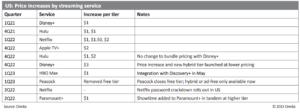
After more than 40 years of operation, DTVE is closing its doors and our website will no longer be updated daily. Thank you for all of your support.
DTVE Data Weekly: The cost of streaming
 In 2019, 2020, and 2021, new D2C streaming services launched globally. To quickly gain subscribers, monthly pricing started as relatively affordable within the video ecosystem.
In 2019, 2020, and 2021, new D2C streaming services launched globally. To quickly gain subscribers, monthly pricing started as relatively affordable within the video ecosystem.
However, running a streaming service is very expensive. Streamers face costs related to R&D, technology, licensing, CDN servers, labor, and UI/UX. In 2023, many studio leaders have warned that streaming content investment is peaking in 2023 and 2024. With cost-of-living increases and potential recession worries on the horizon, Wall Street began pressuring studios to start hitting streaming revenue targets rather than high subscription counts. This has led to what customers have dreaded since the beginning: price hikes.
Many companies have undergone layoffs, services are integrating advertising, services are dropping some licensed content, and some are shifting their slates. However, the easiest and quickest way for a service to see immediate ARPU growth is to increase monthly subscription prices.
Password sharing crackdowns are also essentially a secondary form of price increases. The industry will likely see such measures from other services in the future. As shown in the accompanying table (on the right), D2C streaming services have implemented price increases alongside hybrid tier introductions. All services except Apple TV+ have added an ad-supported tier to the service. In 2023, Peacock also removed the free ad-supported content tier from its service.
Despite slowing subscriber growth rates, price increases have brought immediate revenue boosts to streaming services. Omdia expects total US subscription streaming revenue in 2023 to increase 23% year over year, which is a difficult feat.
Music streaming and Gaming
Price increases have also hit other media and entertainment sectors such as music streaming and gaming. YouTube Premium, the service that removes advertising from the traditional YouTube experience, increased pricing by $2 per month in July 2023. Apple also increased the price of iCloud services and Apple Music across many regions in June. Spotify is raising the price of Spotify Premium from $9.99 to $10.99 per month for the first time since 2011. In July 2023, Xbox Game Pass increased monthly pricing by $1–2, depending on the tier.
D2C streaming is reaching a maturation point where low ARPU models no longer work. The industry must lean on aggregation, consolidation, and advertising to keep services afloat.
Aggressive price hikes drove pay TV into a cord-cutting cycle in the past 5–10 years. As subscribers decreased or flattened, prices increased, and consumers began canceling their subscriptions. As this continued, the prices increased further to offset those revenue losses but have only driven subscribers out faster. If streamers become too aggressive with pricing or begin having price hikes every year, pay TV’s history may begin to repeat itself.
Sarah Henschel is Omdia‘s principal analyst, media & entertainment.



